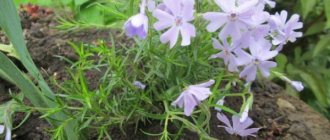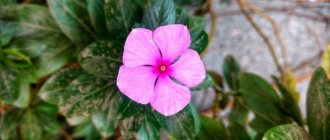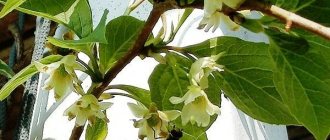Calibrachoa ampelous flower
The plant can feel good both in a pot and in the ground.
Calibrachoa ampelous loves light very much, be it a lamp or the sun, and is drawn to it. However, direct exposure to sunlight has a detrimental effect on the flower, especially in the heat of summer.
Flower close up
To properly care for the plant, you need to keep the flower in the sun only in the morning, when the sun's rays are not so strong. In the complete absence of sunlight, the flower fades.
Description of the Calibrachoa flower, or million bells
Ampelous viola or pansy - cultivation and care
The Calibrachoa ampelous flower became popular not so long ago. The bush itself is quite lush, with small bell flowers. The bud size is approximately 4 cm in diameter.
In the beginning, the plant had only one color - purple. Over time, other colors began to be developed, approximately similar to the rainbow (yellow, pink, white, blue).
Flower in a flowerpot
The length of the stem can reach more than 1 m. The spherical crown is covered with many small buds. They are very soft and pleasant to the touch, somewhat like silk.
For your information! Until 1990, the flower was considered a variety of petunia.
Description of the plant
Calibrachoa is a hanging plant that is directly related to the Solanaceae family.
Photo of beautiful Calibrachoa flowers
This attractive plant is often grown in flowerpots.
The beauty of calibrachoa lies in the abundance of brightly colored flowers. Their size is no more than 30mm. To fully convey the decorative component of the plant, it is kept in a suspended state so that the long shoots fall freely.
Initially, all the inflorescences of the plant were purple in color. Currently, breeders have allowed gardeners to grow calibrachoas with white, red, blue, yellow and brown flowers.
Photo of calibrachoa flowers in flower pots
The plant has a distinctive feature - the presence of a “throat” colored in a different color from the corolla.
Most often it is yellow or brown. The structure of the flower is in most cases simple, resembling an open bell. But there are varieties with double petals. But, it is worth taking into account that varieties with double flowers cannot boast of an abundance of flowering.
Growing Calibrachoa from Seeds
Ampelous pelargonium or geranium - growing and care at home
More recently, gardeners began to practice growing Calibrachoa ampelous flowers from seeds. Previously, only cuttings from the mother plant were used. This is due to the natural feature of the culture.
Note! At the moment, the market has begun to offer various varieties of hybrids that can be grown from seeds even at home. For example, calibrachoa ampelous Calita can be obtained with reduced cuttings.
Caring for seedlings obtained from seeds
It all depends on how to plant the seedlings. If the seeds were buried in peat tablets, picking does not need to be done. In the case of other planting options, picking and thinning are required.
After 3-4 weeks after germination, the seedlings are planted in separate containers. This process must be carried out with caution: lift the flower along with the ground and move it to the flowerpot.
Further caring for Calibrachoa ampelous involves feeding and watering. The bush is not able to tolerate too wet soil.
Note! The irrigation method should be used throughout the day.
In addition, in order for a flower to become a lush bush, you need to constantly pinch it.
Planting and propagation
Calibrachoa is propagated at home by both seeds and cuttings. To plant such beauty on your balcony, you can purchase seedlings.
Buying calibrachoa in the form of seedlings is much more convenient for those who are encountering this plant for the first time, since you can immediately see what the flowers will be like, the health status of the bush, and many other parameters.
The best place to plant or place flowers is a sunny, warm area, but without sun or extreme heat. As reviews from flower growers say about calibrachoa, when the sun is very aggressive, the flower quickly dies, dries out completely, and it is no longer possible to revive it.
Therefore, if the place where calibrachoa seedlings is exposed to scorching rays for some part of the day, then during this time the flowers need to be covered or blocked.
It is also necessary to take into account that a strong wind can break off the branches of a flower and tear up the flowers themselves. Therefore, you should not place plants in very windy places.
for planting calibrachoa , but you need to keep in mind that one plant needs at least 3-4 liters of soil.
When planting flowers in open ground, the distance between the bushes should be at least 40-50 cm. As for the soil, a ready-made soil mixture for profusely flowering perennial plants is ideal for the flower.
The flower propagates by both seeds and cuttings. But, planting and growing calibrachoa from seeds is always a lottery, since the plant does not repeat the qualities of the parent, even the color may be different. Therefore, gardeners prefer to propagate flowers by cuttings or simply by dividing one bush into several.
As for purchased seeds, the majority are Dutch hybrid varieties and need to be pre-germinated. The ideal option would be to plant in a peat pot in March - April, so that in May the plant can already take its place in the flower garden.
Flowers cannot tolerate cold; they need to overwinter at a temperature of 5 to 10 degrees; cuttings cut in the fall and planted, divided bushes should be kept at the same temperature.
Caring for calibrachoa in the open field and at home
Fuchsia ampelous - description of varieties, cultivation and care at home
The main thing is the location. A flower can thrive satisfactorily not only in a flowerpot, but also in the ground.
Important! There is a certain nuance to growing a flower. Bright light from the sun in summer can easily ruin a flower; you need to be careful with it, because it is like silk.
The calibrachoa ampelous flower requires proper care: you need to make sure that it “bathes” in the sun’s rays in the morning and is in the shade during the daytime. If done incorrectly, this can lead to dullness of the flower.
Bushes can also be grown in flowerpots. For good growth, take 3-4 kg of soil per flower. The plant requires loose soil. The flower should have constant watering, but not very often. If it is too abundant, you can pour it in, and the calibrachoa will disappear.
Features of caring for calibrachoa in winter
The bush can survive the winter safely. When spring comes, the plant very quickly rehabilitates itself and begins to bloom.
There are various ways to store calibrachoa cuttings:
- In a refrigerator. This method is intended for gardeners who do not have a cellar and grow flowers on a sufficient scale. After the refrigerator, when the plant returns to its planting site, it will shed its shoots and begin to gain mass.
Watering
- In the basement. With the arrival of the first frosts in the fall, mature bushes are thrown away. To store in the basement, you need special conditions and a certain temperature (not lower than 10⁰C). The plant is stored until February.
- On the windowsill. If the first frost has already appeared outside, and the flower continues to bloom, in order to preserve it, you need to bring it into the house and place it on the windowsill and continue with your usual care.
For your information! In the conditions of Central Russia, it is very difficult for a bush to survive; it may not survive the winter. Basically, gardeners purchase cuttings in advance every new season.
Watering and humidity
Calibrachoa ampelous is quite sensitive to soil moisture. It should be watered only when the crust is dry. For proper watering, heated water in the sun is recommended. In summer you should water several times a day.
Important! When caring, the soil should always be slightly moist. This flower especially likes to be sprayed during the day.
Choosing a landing site
The bush can take root in the ground, at home on a loggia or on a windowsill on a balcony, the most important thing is that the windows face sunlight. At home, he will not be disturbed by weather elements that can harm him.
Flower on the balcony
How to prevent diseases and pests
If the plant is not properly cared for, various diseases can occur:
- black leg (too densely planted shoots);
- powdery mildew (humidity in the hot season, temperature changes);
- chlorosis (high calcium levels).
Blackleg can be identified by the softened part of the stems.
Powdery mildew is identified by the appearance of a white coating.
Chlorosis is visible by the unusual color of the leaves.
For your information! Insecticides intended for petunias will help get rid of ailments.
Bush formation
The bush needs to be trimmed periodically to maintain its beautiful shape. The first pruning is carried out after flowering, further pruning is carried out in the summer, shortening the shoots.
What is the difference between calibrachoa and petunia?
When considering different specimens (from a scientific point of view), the first difference is in the chromosomes. Petunia has four fewer chromosomes, but this does not stop gardeners from getting confused about the names.
There is one more difference. Calibrachoa ampelous has dense vines and the flower does not exceed a few centimeters in diameter; the quantity is compensated by its small size.
Calibrachoa ampelous from the outside looks like petunia, but with a detailed study of the stem it is possible to see the difference in diameter.
By planting calibrachoa, the gardener will receive a lush flowering ball, completely covered with bell flowers. You will have to tinker with the care, but the result is worth it!
The difference between petunia and calibrachoa
Some garden centers offer consumers the opportunity to purchase calibrachoa under the name surfinia or ampelous petunia. For those who want to easily distinguish between plants that are similar to each other, the following information will be useful.
The difference between calibrachoa and ampelous petunia - video
Calibrachoa has flowers whose size does not exceed 30 mm. The presence of a yellow or brown throat on the throat of the flower is another indisputable fact in favor of Calibrachoa. The foliage is also significantly different from the petunia leaf blades. It is smaller than that of surfinia, only 40 * 10 mm and all covered with villi. This “edge” is present on leaves and stems. The structure of the stem is the third criterion. In calibrachoa it is not flexible like petunias, but rather tends to become lignified.











